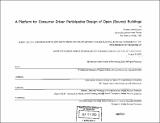A platform for consumer driven participative design of open (source) buildings
Author(s)
McLeish, Thomas John, 1970-
DownloadFull printable version (21.30Mb)
Other Contributors
Massachusetts Institute of Technology. Dept. of Architecture. Program In Media Arts and Sciences
Advisor
Kent Larson.
Terms of use
Metadata
Show full item recordAbstract
Homes in the future will contain many new and complex activities, becoming centers for work, commerce, learning, proactive health care, distributed energy production, etc.. The baby boomer and GenX population are demanding choice and tailored solutions in all products they buy, including homes. The combination of societal and market forces will require new ways of designing, building, and integrating technologies into places of living. The housing industry, however, is poorly prepared for this future, creating mostly generic low-grade, inflexible, disruptive-to-upgrade, and high-maintenance products. Few are tailored to the unique and changing needs of its occupants. The industry lacks a process that will lead to the customization of homes that respond to the unique values and needs of occupants, and architects/engineers play no significant role in the creation of most places of living. To address these problems, I propose that a new model for design and construction that places the consumer in the center of the design process. In this model, developers become integrators (cont.) offering a process for customization; architects create design engines and computational critics rather than a single design; industry provides tailored product and service information directly to the consumer at the point of decision; and fabricators receive data to manufacture customized cabinetry-like components for just- in-time delivery and assembly. To demonstrate and test the viability of this approach, I have built a participative design platform for non-experts that could be used by consumers to drive informed customization of their home. Central to this process is an interface that allows consumers to access sophisticated design tools without requiring them to think like an expert designer - providing the information and visualization needed to make informed decisions about adjacencies, form, materials, appliances, etc.. This approach could be extended to include the configuration of customized technologies and services. If adopted by industry, such a strategy could create powerful incentives for innovation.
Description
Thesis (S.M.)--Massachusetts Institute of Technology, School of Architecture and Planning, Program in Media Arts and Sciences, 2003. Page 117 blank. Includes bibliographical references (p. 78-79).
Date issued
2003Department
Program in Media Arts and Sciences (Massachusetts Institute of Technology)Publisher
Massachusetts Institute of Technology
Keywords
Architecture. Program In Media Arts and Sciences